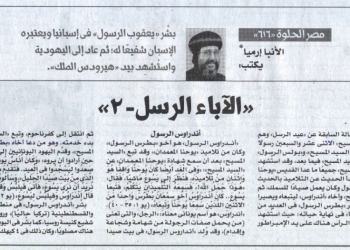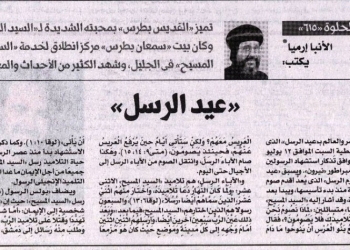In the previous article, we spoke about Multi-Egypt and started with the multiplicity of civilizations. Civilizations began early on her land, one which accommodated numerous civilizations, which made the Egyptian personality unique. We also tackled the Pharaonic civilization in the Old Kingdom. Today, we shall resume talking about this civilization.
According to what we said, with the end of the Old Kingdom and the downfall of the sixth dynasty, chaos overwhelmed Egypt and she returned to her condition before the unification. She plunged into a period of poverty and warfare from the seventh to the tenth dynasty, after which the two lands were unified, and an era of cultural and economic revival started. This was known by the name of the “Middle Kingdom”.
The Middle Kingdom 2060-1785 B.C.
The Middle Kingdom was a prosperous one. The eleventh and twelfth dynasties ruled Egypt during that era. The country was reunited, which led to prosperity and stability. Literature, especially narratives, flourished. Also, a great legacy of architecture and engravings was established. A plan was set to cultivate the land, and a system was laid for irrigation in order to increase agricultural products. A canal was dug to connect the Nile with the Sea, and Nilometer was made.
Moreover, the army restored Nubia which was full of gold and quarries and made a defense base in Eastern Delta to resist foreign attacks. The security of southern Egypt was given attention through establishing defense fortresses, and art and religion flourished.
d. The Eleventh Dynasty
This dynasty started by succumbing Upper Egypt, after which its authority extended to the rest of the country until Mentohotep II, the most famous of its kings, reunited Egypt. Many kings followed suit, supporting this unity and overcoming civil wars.
e. The Twelfth Dynasty
The tenure of the twelfth dynasty is among the most prosperous in the Egyptian history. Amenemhat I is the first king of this dynasty. He gave attention to securing the country’s borders. His was an era of peace and safety. He was succeeded by kings who followed suit, most famous of whom were Senusret I, Senusert III, and Amenemhat III. They controlled the country’s borders and gave attention to mining. Senusert III dug a canal east of the Delta between the Suez Gulf and the Nile. Amenemhat III devised the idea of a great store to preserve the Nile water during the flood, which he did near al-Fayyum.
f. The Second Intermediate Period
Chaos, weakness, and deterioration overwhelmed the country after the twelfth dynasty. Likewise, wars and rebellions broke out due to the conflict over authority. This led to the Hiksos’ occupation of the country. This took place from the thirteenth to the sixteenth dynasty. Then, they were expelled from Egypt during the era of the seventeenth dynasty which lasted for about 225 years.
g. The Thirteenth and Fourteenth Dynasties
The thirteenth and fourteenth dynasties conflicted to rule Egypt. So much so that one ruled the south, and the other the Delta. In effect, the country was split once more. Consequently, she was invaded by Asian tribes, the Hiksos, that spread all through.
h. The Hiksos and the Fifteenth to the Seventeenth Dynasty
The Hiksos imitated the Egyptian ruling system. So, they established an authority and lent themselves the title of “king of Egypt”. They continued to rule Egypt from the fifteenth to the seventeenth dynasty. They tried to befriend the Egyptians who did not believe them.
As for the Pharaohs, they assembled in Thebes, in an attempt to get ready to liberate the country. After a long conflict by the seventeenth dynasty during the tenure of Seqenenre Tao when Thebes had become strong, a war broke out with the Hiksos. Though Seqenenre Tao achieved some success, he did not live long. He was succeeded by his son Kamose who continued fighting them.
The Hiksos were completely expelled from Egypt by Ahmose I who followed them to Syria. Ever since, the military became the Pharaohs’ top priority: for they strove to extend Egypt’s borders and emphasize her dominion on the Near East.
The New Kingdom 1580-1075 B.C.
The New Kingdom which era was called that of military glory and the empire after expelling the Hiksos from Egypt. It extended through the tenure of the eighteenth and nineteenth dynasties.
The Pharaohs established a new kingdom that witnessed unprecedented prosperity through securing the country’s borders, controlling them, and enhancing the diplomatic relations with her neighbors. Likewise, military campaigns were launched, and Egypt dominated Syria and succumbed Nubia. Also, a maritime fleet, consisting of 50 ships, was sent to Somalia for trade. At that time, Egypt became predominant in Western Asia, Syrian and Palestinian cities, and the Mediterranean islands. Though this dominion was lost and the empire was trampled by the Hittites, Palestine was returned, the Libyans were expelled from Western Delta, and Egypt regained her military glory. Because stability overwhelmed Egypt, construction was given attention, and edifices were built to glorify great achievements. Likewise, obelisks, temples, and statues were built. The first peace treaty in history came to exist.
i. The Eighteenth Dynasty
Historians assert that Ahmose is the founder of the eighteenth dynasty which had many prominent kings in Egypt’s history. That is because he secured the country’s southern borders and Nubia and succumbed many country to Egypt’s dominion. Then, he started rebuilding the country, which was given attention by his successors. Of these is Thutmose II who reached Syria, Euphrates, and Ethiopia southward with his army: for, at that time, Egypt’s army was strong and well-trained due to the wars it took part in.
Queen Hatshepsut, wife of Thutmose II succeeded him as “prince regent” for his son Thutmose III. She sent a commercial expedition to Somalia. Historians assert that she among Egypt’s wise queens.
Thutmose III’s tenure was quite a prosperous era in Egypt’s military history: for her dominion reached Kurdistan, Armenia in Asia Minor, Syria and Palestine, as well as Ethiopia. Amenhotep III is also among the dynasty’s prominent kings: for he was adept at politics and military affairs. He was pretty able to preserve the empire’s provinces. He constructed many edifices in the country.
Amenhotep IV, who called himself Akhenaton, cared for religious affairs, calling for worshipping one deity, Aton, the sun god. Yet, his successors returned to the old creed worshipped Amoun after his death.
The eighteenth dynasty ended up in the tenure of Horemheb who reorganized the country after the religious turmoil that alighted upon her. He sent expeditions to Nubia and cared for building edifices. Likewise, he decreed laws for protecting the weak and overcoming violence.
f. The Nineteenth Dynasty
Historians assert that Seti I is not just one of the nineteenth dynasty’s great kings, but also one of the greatest kings in Egypt’s history. He established peace, safety, and prosperity in Egypt. He also dug a canal between the Nile and the Red Sea and cared for construction and building obelisks.
Ramses II is another important king in this dynasty: for history owes him the first peace treaty which he made after the Battle of Qadesh: whereby wars had lasted for a long time between Ramses and the country under Egypt, especially that of the Hittites. After that long warfare, Ramses gave attention to the country’s internal affairs, caring for prosperity, construction, and legislation.
Merneptah is the last powerful king of this dynasty. He strove to preserve his ancestors’ victories. Yet, he did not care much about training the armies, which made Egypt susceptible to occupation, had it not been to his resorting to Ramses II’s troops who fought well and preserved the country’s security.
j. The Twentieth Dynasty
This dynasty showed up after the tenure of many weak kings in the nineteenth dynasty. It marks a middle era between the glory of the Egyptian kingdom and the third Intermediate period. Ramses III is one of its greatest kings for he restored order to the country and resisted enemy’s raids. So, peace and safety prevailed. He constructed many edifices, and protected Egyptian trade and industry. With the end of this dynasty’s tenure, Egypt has already deteriorated internally and lost her entire dominion on the outside. Even more, she was attacked by enemies.
k. The Third Intermediate Period
The third intermediate period lasted for about 420 years from the tenure of the twenty-first to the thirtieth which marks the end of the Pharaonic era.
From the twenty-first to the twenty-sixth dynasty, Egypt deteriorated economically, politically, and culturally. She lost her dominion on Syria and Palestine, only to have Nubia left. Egypt’s wealth and economic prosperity made foreign powers covet her. These threats, along with internal problems, increased.
From the twenty-seventh to the thirtieth dynasty, Egypt was ruled by the Persians which ended with the advent of Alexander the Great, only to start a new era that bears a new civilization for Egyptians. What an interesting story! Stories never end in Beautiful Egypt.
General Bishop
Head of the Coptic Orthodox Cultural Center


 العربية
العربية











